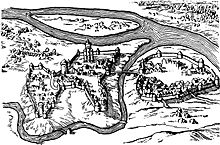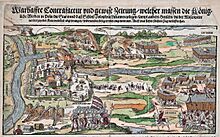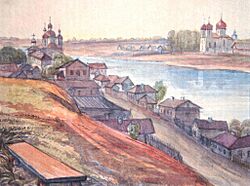Polotsk facts for kids
Quick facts for kids
Polotsk
Polatsk
|
|||
|---|---|---|---|
 |
|||
|
|||
| Country | Belarus | ||
| Region | Vitebsk Region | ||
| District | Polotsk District | ||
| Founded | 862 | ||
| Area | |||
| • Total | 40.77 km2 (15.74 sq mi) | ||
| Elevation | 111 m (364 ft) | ||
| Population
(2024)
|
|||
| • Total | 79,579 | ||
| • Density | 1,951.90/km2 (5,055.4/sq mi) | ||
| Time zone | UTC+3 (MSK) | ||
| Postal code |
211291, 211400—211402, 211404—211415, 211422
|
||
| Area code(s) | +375 214 | ||
| License plate | 2 | ||
Polotsk (also called Polatsk) is a historic town in Belarus. It is located in the Vitebsk Region and sits on the Dvina River. Polotsk is an important administrative center for the Polotsk District. As of 2024, about 79,579 people live there.
Contents
What's in a Name?
The name Polotesk comes from the Polota river. This river flows into the nearby Western Dvina. Long ago, the Vikings called this place Palteskja.
Exploring Polotsk's Geography
Lakes Near Polotsk
- Lake Babyna
A Journey Through Polotsk's History
Polotsk is one of the oldest cities mentioned in the history of the East Slavs. It was first written about in the year 862. However, archaeologists believe Polotsk existed even earlier, in the first half of the 9th century.
Early Rulers and Royal Families
The first known leader of Polotsk was Prince Rogvolod, who ruled from 945 to 978. He had a daughter named Rogneda. Rogneda was supposed to marry Yaropolk, the prince of Kiev. But Yaropolk's brother, Vladimir, attacked Polotsk first. Vladimir killed Rogvolod and his family, then married Rogneda.
Vladimir and Rogneda had five children. Their oldest son, Izyaslav, later became the Prince of Polotsk, ruling from 989 to 1001.
Polotsk's Rise to Power
Between the 900s and 1100s, Polotsk became a very powerful center in what is now Belarus. It was a major political capital and controlled important trade routes. The most powerful ruler during this time was Prince Vseslav of Polotsk, who reigned from 1044 to 1101. You can still see an old inscription from the 12th century, made by Vseslav's son Boris, on a huge stone near St. Sophia Cathedral. This stone is known as a Boris stone.
Changing Hands and New Laws
Polotsk was lucky during the Mongol invasion because it was not attacked or forced to pay tribute. However, in 1240, it became connected to the Lithuanian princes. In 1307, the Grand Duke of Lithuania, Vytenis, took control of the city. This helped the Lithuanians control the important Dvina trade route.
In 1498, Polotsk adopted Magdeburg law, which gave its citizens more rights and self-governance. Polotsk was the capital of the Połock Voivodship within the Polish–Lithuanian Commonwealth until 1772. It was captured by the Russian army in 1563 but returned to Lithuania 15 years later. Russia captured it again in 1654, but Poland–Lithuania took it back in 1660 during the Russo-Polish War (1654–67).
Polotsk in Later Centuries
In 1772, Russia took control of Polotsk as part of the First Partition of the Polish–Lithuanian Commonwealth.
During this time, the Jesuit College in Polotsk became very important. It was founded in 1580. In 1812, it became the Połock Academy, a major school with different subjects, libraries, a printing house, and even a theater. Many important books and scientific collections were kept there.
However, in 1820, the Russian Emperor Alexander I closed the Academy and sent the Jesuits away. The Academy's large library, with thousands of old books, was broken up and sent to other cities.
Polotsk also saw two battles during the French invasion of Russia in 1812. Later, it was occupied by Germany during World War I and by Poland during the Polish–Soviet War. During World War II, Nazi Germany occupied Polotsk from 1941 to 1944.
Polotsk's Cultural Heritage
Polotsk has a rich cultural history. The city's Saint Sophia Cathedral was built between 1044 and 1066. It was a symbol of Polotsk's independence, just like similar churches in Novgorod and Kyiv. The current building is from the 1700s, as the original was damaged.
You can also find old 12th-century buildings, like the Transfiguration Church, in the Convent of Saint Euphrosyne. This convent also has a newer church built in the late 1800s.
Important People and Creations
- Euphrosyne of Polotsk: A nun who lived from 1120 to 1173. She built monasteries, copied books, and encouraged people to read. She also supported art, including the famous "Cross of Saint Euphrosyne," a national treasure that was lost during World War II.
- Francysk Skaryna: Born in Polotsk around 1490, he was the first Belarusian printer. In 1517, he printed the Bible in the Old Belarusian language. This was only a few years after the first Czech Bible and decades after Johann Gutenberg printed his first book.
- Monument to a Unique Letter: In 2003, Polotsk dedicated a monument to the unique Cyrillic Belarusian letter Ў. This letter is special because it's not used in any other Slavic language! The idea for the monument came from a Belarusian calligraphy professor named Paval Siemchanka.
Sports in Polotsk
Polotsk has produced players for the Belarus national bandy team. Bandy is a sport similar to ice hockey.
Famous People from Polotsk
Many notable people have connections to Polotsk:
- Uładzimir Arłou (b. 1953), Belarusian historian and writer
- Lyavon Barshchewski (b. 1958), Belarusian language expert and politician
- Euphrosyne of Polotsk (1120–1173), nun and patron of the arts
- Francysk Skaryna (c. 1490–1551), first Belarusian printer
- Izyaslav of Polotsk (978–1001), Prince of Polotsk
- Josaphat Kuntsevych (c.1580-1623), a saint in the Roman Catholic Church
- Mary Antin (1881–1949), American author and activist
- Rogneda of Polotsk (c. 962–1002), princess
- Rogvolod (ruled 945–978), first known prince of Polotsk
- Sophia of Minsk (c. 1140–1198), Queen of Denmark
- Symeon of Polotsk (1629–1680), poet and religious figure
- Vseslav of Polotsk (c. 1039–1101), powerful Prince of Polotsk
- Natalya Kochanova (b. 1960), speaker of the Council of the Republic of Belarus
Images for kids
See also
 In Spanish: Pólotsk para niños
In Spanish: Pólotsk para niños




















